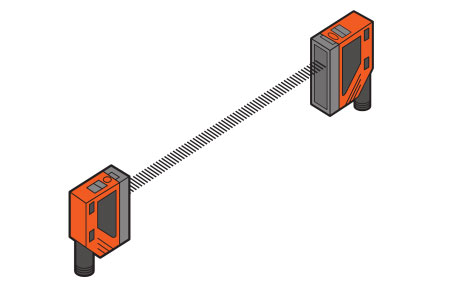Key Takeaway
Sensitivity in a photoelectric sensor refers to its ability to detect small objects and the distance at which it can do so. Sensitivity is adjustable depending on the application. When set to maximum sensitivity, the sensor can detect small objects, sometimes as small as 30% of the lens diameter.
This high sensitivity is crucial for precise object detection in industries like packaging and manufacturing. Adjusting sensitivity helps reduce false detections from background objects and ensures reliable performance in different environments.
Understanding Sensitivity in Photoelectric Sensors
The sensitivity of a photoelectric sensor determines how well it detects objects, especially in challenging environments. Sensitivity is often confused with accuracy, but they’re not quite the same. Sensitivity refers to how small or faint an object can be for the sensor to detect it. Higher sensitivity allows the sensor to detect smaller or more transparent objects, while lower sensitivity might filter out unwanted signals. A good analogy would be the sensitivity of a microphone: just like a microphone picks up faint sounds when set to high sensitivity, a sensor detects even the slightest object or signal change when its sensitivity is optimized.
Getting the sensitivity just right is crucial for ensuring that the sensor can accurately perform its job without triggering false positives. In industrial environments, this fine-tuning can be the difference between efficient operations and costly disruptions.

Factors That Affect Sensor Sensitivity
When it comes to sensor sensitivity, many factors can influence the overall performance of photoelectric sensors. The environment plays a huge role. Dust, moisture, and dirt can cause interference, and in some cases, the sensor might mistake these particles for the actual object, leading to inaccurate results. This is why high-sensitivity sensors can sometimes be more of a problem, as they might detect unwanted contaminants. Another significant factor is the nature of the object being detected. Different materials, colors, and textures react differently to sensors. For instance, reflective or light-colored objects are typically easier to detect than darker or non-reflective surfaces.
Distance is another key player in sensor performance. If a sensor is placed too far from the target, its sensitivity needs to be higher to accurately detect the object. On the other hand, if the sensor is too close, background noise or nearby objects might be falsely detected. This delicate balance between distance, object properties, and environmental factors is critical to achieving the perfect setup for your sensor application.
How to Adjust Sensor Sensitivity for Optimal Performance
Adjusting a sensor’s sensitivity is often more art than science, especially for engineers new to the field. The process itself might seem simple—many sensors come with an adjustment knob or a digital interface—but getting it right can take some trial and error. The goal here is to set the sensitivity high enough to detect the target object but low enough that environmental factors like dust or other irrelevant stimuli don’t trigger false alarms.
A good starting point is to set the sensitivity at its lowest setting and then gradually increase it until the sensor starts reliably detecting the object in question. If the sensitivity is too high, the sensor may become overwhelmed with irrelevant data, causing inefficiencies and false signals. Engineers often find that fine-tuning the settings in small increments helps achieve the desired outcome with minimal fuss. And once you’ve got it just right, it can make a world of difference to the sensor’s accuracy and reliability in real-world applications.
Measuring and Testing Sensitivity in Different Environments
No two environments are the same, which makes testing sensor sensitivity crucial before deploying it in an industrial setting. In a lab, where conditions are clean and controlled, sensors might perform flawlessly. But move the same sensor to a busy factory floor, and you may notice different results due to the introduction of dust, moisture, or even temperature changes. Therefore, testing the sensor under real-world conditions is vital for determining the appropriate sensitivity settings.
One effective way to test a sensor is to recreate the conditions it will operate under. Start by exposing the sensor to the objects it’s meant to detect while simulating environmental challenges like dust or moisture. Keep an eye on the sensor’s response to ensure it’s accurate and not picking up false signals. Testing under varying conditions helps engineers identify potential issues and fine-tune sensitivity settings to minimize downtime and maximize operational efficiency.
How Sensitivity Impacts Detection Accuracy
Sensor sensitivity and detection accuracy go hand in hand. While sensitivity refers to how well a sensor picks up on objects, accuracy is about how reliably the sensor identifies them. Overly sensitive sensors may lead to false detections, flagging objects that aren’t there, while under-sensitive sensors risk missing key objects altogether. In an industrial setting, this balance is crucial to maintaining a smooth and efficient production line.
Understanding how sensitivity impacts accuracy is essential for industrial engineers. If a sensor’s sensitivity is set too high, it may detect irrelevant stimuli, reducing overall system efficiency. On the flip side, setting it too low might cause the system to miss critical objects, leading to safety concerns or production inefficiencies. Striking the right balance not only enhances accuracy but also ensures the production line runs smoothly, saving both time and money in the long run.
Conclusion
In the world of industrial automation, sensor sensitivity is not something to overlook. It plays a key role in ensuring accurate detection and efficient operation. By understanding how to adjust and measure sensitivity, you can make sure that your photoelectric sensors are working at their best, reducing the risk of errors and maintaining high levels of productivity. For new engineers, mastering sensor sensitivity will be a critical skill that can improve the reliability and accuracy of your work, ultimately contributing to the success of the entire operation.
